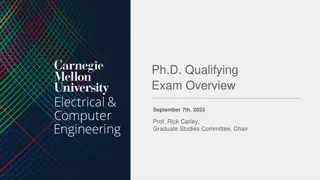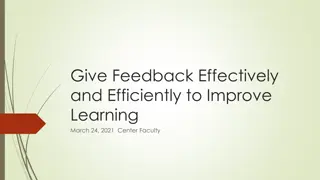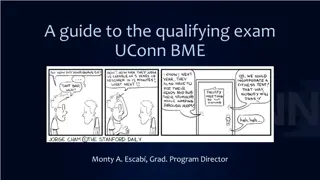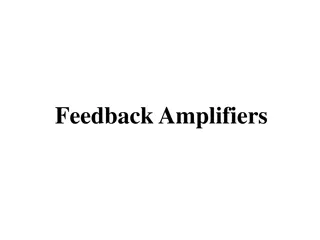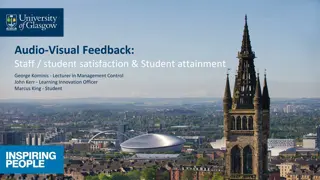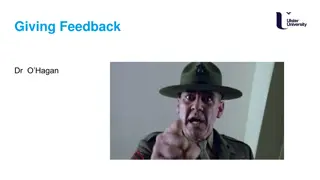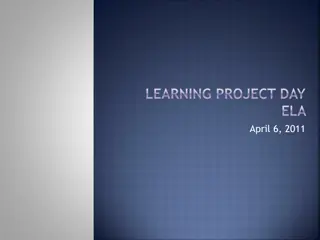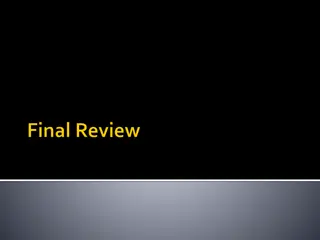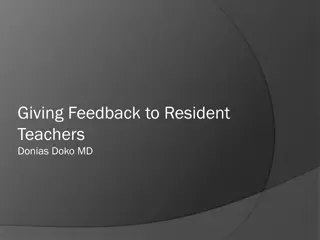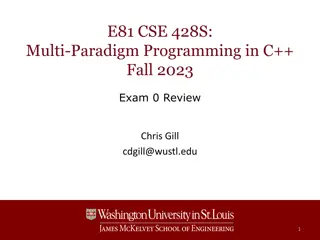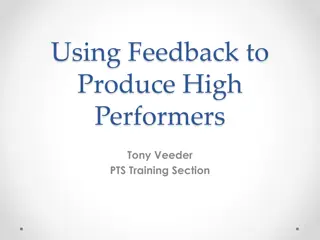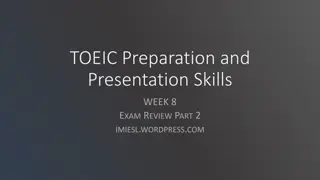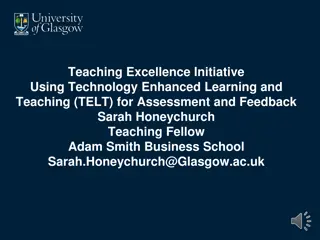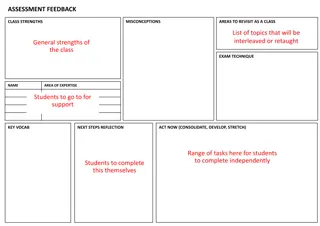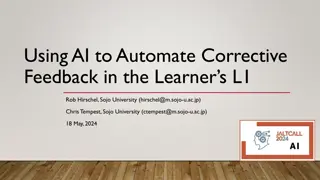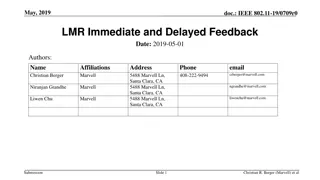Analysis of Single Component Assessment Exam Feedback for S112 Module
The assessment strategy for the S112 module involves a single exam component alongside several TMAs. Findings show little gaming of the system, with most students submitting assignments. Exam performance correlates with the number of assignments submitted. The outcome of the module seems to be affected by concurrent module studies. Previous module study has an impact on the S112 outcome. The data reveals a detailed analysis of student performance and outcomes related to the S112 module.
Download Presentation

Please find below an Image/Link to download the presentation.
The content on the website is provided AS IS for your information and personal use only. It may not be sold, licensed, or shared on other websites without obtaining consent from the author. Download presentation by click this link. If you encounter any issues during the download, it is possible that the publisher has removed the file from their server.
E N D
Presentation Transcript
Single Component Assessment Exam and Exam Feedback: the S112 experience Jim Iley and Nick Adams
BACKGROUND S112 is second Stage 1 60-credit module in multiple qualifications Eight learning outcomes Single-component assessment: exam only Stage 1 module in university Exam 61% TMA 05 10% TMA 02 10% TMA 06 10% TMA 03 3% TMA 04 3% TMA 01 3% TMAs 01/03/04 assess topic learning TMAs 02/05 assess practical work; TMA06 assesses communication Exam assesses the remaining FIVE learning outcomes No thresholds on any component 2
FINDINGS Little gaming of the assessment strategy Exam performance related to number of assignments submitted Module outcome adversely affected by study of concurrent modules S112 outcome better in terms of proportions of distinctions and failures: S111>U116>SDK100 Most popular subsequent modules in 18J were S294 and S295 Subsequent withdrawal highest from S215 Stage 2 performance shows correlation to S112 performance S209 performance better than those who have not completed S112, but S215 performance poorer 3
Assignment submissions No evidence of gaming 7 students did exam only (4 pass, 3 fail) Assessment strategy appears to encourage assignment submission Number of TMAs submitted 2017J/% 2018J/% 0 1 2 3 4 5 6 0.7 0.5 1.6 1.7 3.5 10.1 81.9 0.2 0.4 0.9 1.4 3.3 11.5 82.2 4
Exam performance related to number of assignments submitted No. of TMAs submitted 0-2 3 4 5 6 Number of students 35 26 56 180 1359 Average exam score 59.6 60.5 57.9 62.6 67.5 5
Module outcome adversely affected by study of concurrent modules No. of concurrent modules 0 1 2 17J Numbers of students 550 179 22 Average TMA score 76.6 69.4 64.6 Average exam score 66.5 65.9 62.4 Average overall score 70.4 67.2 63.3 No. of concurrent modules 0 1 2 18J Numbers of students 713 185 7 Average TMA score 75.6 73.1 65.9 Average exam score 66.9 65.2 65.6 Average overall score 70.3 68.3 65.7 6
Effect of previous module study on S112 outcome Combined 17J and 18J cohorts S111 U116 SDK100 139 students S112 result 698 students 401 students Distinction 20.6% 15.2% 8.6% 77.4% Pass 82.5% 85.6% Fail 2% 2.3% 5.8% 7
Behaviour of 17J S112 students on 18J Stage 2 modules: S112 Passes Numbers of 17J S112 'pass' students and subsequent behaviour on Stage 2 modules Most of the 17J S112 students studied S294 and S295 160 140 Numbers of students 120 In absolute terms, withdrawals from S209 were the lowest 100 80 60 40 20 0 S206 S209 S215 S294 S295 SK299 Withdrew before start Withdrew after start Completed Stage 2 module 8
Withdrawals of 17J S112 students from 18J Stage 2 modules: S112 Passes Students gaining a pass on S112 are more likely to withdraw from S215 than any other module by a factor of almost 2 S112 withdrawals are evenly spread across the module No. of S112-17J pass students withdrawing from S215-18J 4 5 5 3 4 5 0 2 1 Month Oct 2018 Nov2018 Dec 2018 Jan 2019 Feb 2019 Mar 2019 Apr 2019 May 2019 Jun 2019 9
Stage 2 Module performance versus 17J S112 performance Correlation between Stage 2 exam performance and S112 exam performance r2 = 0.4-0.5 for 5 of 6 modules S294 SK299 r2 = 0.5 r2 = 0.4 For S215 correlation is considerably poorer r2 = 0.2 S215 Some students do very well on S215 (but not S112); others very well on S112 (but not S215) r2 = 0.2 10
17J Student performance on 18J Stage 2 modules S112 students versus the rest Stage 2 performance difference between students who had and those that had not studied S112 6.00% 4.00% Students who have completed S112 do better 2.00% OES TMAs 0.00% S206 S209 S215 S294 S295 SK299 Students who have completed S112 do worse -2.00% -4.00% S112 students who then study S209 do slightly better than those who have not studied S112 S112 students who then study S215 do slightly worse than those who have not studied S112 11
S112 and the exam feedback pilot Nick Adams, Dan Berwick and Jim Iley With grateful acknowledgement to the original Exam Feedback Pilot Team (Sarah Clayton, Georgina Middlemiss, Judith Pickering)
APPROACH Ran in 17J Approach to feedback left open to participating module teams S112 approach: fully automated using an Excel form template algorithmic, programmable consistency across markers/feedback providers customised feedback based on input challenging setup but easy to operate at scale (c. 700 scripts) quick to produce custom feedback to be copied and pasted Tried this approach with TMAs to mixed reception (largely negative) Academic feedback scripted by Dr Daniel Berwick Translated/programmed by Nick Adams 13
FINDINGS Most common open comment from students (S112 or otherwise) - exam feedback is most useful alongside the student s original script Automated feedback works well but needs very careful crafting if it is to be: relevant to the student / look human ; programmable; and easy for markers to use in a short period of time. Feedback should prioritise questions most likely to cause problems = learning points Single voice (combining feedback comments from multiple question authors likely to require further work!) 5,000 character limit on OSCAR Requires a bespoke template for each exam 14
WHAT DID THIS LOOK LIKE IN PRACTICE? Academic script 15
WHAT DID THIS LOOK LIKE IN PRACTICE? Programmed feedback form 16
WHAT DID THIS LOOK LIKE IN PRACTICE? Guidance to markers 17
HOW WAS IT RECEIVED? By markers Module %/students agree enough detail %/students satisfied with feedback Canned rating Positivity rating Generally this is working really well and is pretty idiot-proof in that all has to be completed before the comments appear in the box at the end. S112 8 7 65 69 A227 5 8 54 69 Pilot study evaluated marker experience by assigning positivity rating S112 scored highly here Correlated with level of canned feedback Script markers generally happier when provided with illustrative text rather than creating feedback from scratch DD209 0 7 23 48 DD211 3 2 35 53 DE200 7 3 52 59 KYN317 3 3 53 62 L203 3 5 67 86 L204 3 5 42 60 L211 3 5 38 65 18
HOW WAS IT RECEIVED? By students 89.9% (89/99) agreed that they understood the feedback they received (2nd highest) 65.3% (66/101) agreed that there was enough detail in the feedback (2nd highest) 68.7% (68/99) agreed that they were satisfied with the feedback (3rd highest) 61.4% (62/101) agreed that the feedback helped them become aware of their strengths and weaknesses (3rd highest) 58.6% (58/99) agreed that the feedback would help them improve their skills in taking exams (3rd highest) 60.0% (60/100) agreed that the feedback would be useful as they go on to start their next module (3rd highest) 19
FUTURE WORK More detail on marker/module team experience Repeat for future S112 exam, perhaps in conjunction with trial of making scripts available to students Quantitative analysis of S112 specific open comment data 20
Questions? 2 1
Stage 2 Module performance versus 17J S112 performance Correlation between Stage 2 exam performance and S112 exam performance r2 = 0.4-0.5 for 5 of 6 modules S206 S209 For S215 correlation is considerably poorer r2 = 0.2 S294 S295 Some students do very well on S215 (but not S112); others very well on S112 (but not S215) SK299 S215 23
Withdrawals of 17J S112 students from 18J Stage 2 modules: S112 Distinctions Students gaining a distinction on S112 are more likely to withdraw from SK299 than any other module 24
BACKGROUND Project conceived under Students First Transformation More Students Qualifying objective Survey data (SEFAR project, 2015) indicated that most students (70.6%) did not receive or were not satisfied with feedback from their examination Principle 5 of OU Principles for Assessment Practice: feedback should be given on all assessments to support students in moving forwards to their next assessment of module (APC-2013-03-01). Involved nine modules across FASS, STEM (S112) & WELS, spanning Levels 1-3 Ran during S112 s first (17J) presentation so used in 2018 F1 (June) conflation 25
WHAT DID THIS LOOK LIKE IN PRACTICE? Adding comments on OSCAR 26
REFERENCES/LINKS Cross, Simon; Whitelock, Denise and Mittelmeier, Jenna (2016). Does the Quality and Quantity of Exam Revision Impact on Student Satisfaction and Performance in the Exam Itself?: Perspectives from Undergraduate Distance Learners. In: EDULEARN16 Proceedings, IATED Academy, pp. 5052 5061. Available at http://oro.open.ac.uk/46937/ APC-2013-03-01 New Models of Assessment and Tuition Assessment Principles Exam Feedback Pilot Evaluation Report Jan 2019 Provision of Examination Feedback (Office of the Pro-Vice-Chancellor (Students) intranet) 27





